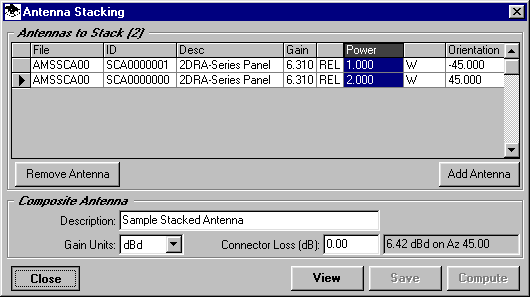
Q: How can I compute the pattern of vertically stacked directional antennas?
A: The TAP Stacked Antenna program can compute an estimate of the combined azimuth plane pattern of multiple antennas stacked on a common vertical axis.
The Stacked Antenna program combines the horizontal plane patterns of multiple antennas (as many as you want to enter into the program) for a preliminary antenna design. This program is not to be considered definitive when planning a stacked antenna array. Precise modeling can only be done when antenna spacing and phasing are considered on every horizontal and vertical angle, which are beyond the scope of this program. The phase of the electric field intensity produced by each antenna on a given azimuth is necessary to compute accurately the stacked array field produced on that azimuth. Since this azimuth phasing information is not generally available from antenna manufacturers, the results of this program should be considered a preliminary design. Final antenna selection and design of a stacked array should include measured pattern data from the antenna manufacturer, or calculations based on the manufacturer’s phasing information.
The Stacked Antenna program enables you to import the antenna parameters from any of the TAP Antenna Library files. The program combines the horizontal plane (or "azimuth") pattern of multiple directional antennas, including the effects of uneven power distribution and different azimuth orientation for each antenna. The program assumes the antennas are stacked vertically, with no electrical coupling between the antennas that would affect the individual horizontal pattern of each antenna. You should consult the manufacturer of the antennas you plan to stack to determine the suggested vertical spacing (typically 0.6 to 1.0 wavelengths). Note that no vertical plane (or "elevation") pattern is computed for the composite antenna array.
From the TAP menu, select Editors, then Antennas, and then Stacked Antennas:

The Antenna Stacking form will be displayed:

This form shows a listing of the antenna patterns to be combined.
To add another antenna to the list, click the Add Antenna button:

The standard TAP Antenna Lookup form will be displayed. First, select the antenna library file you want to use. Click the selection button at the left end of the row to highlight the library you want, then click the Continue button:

The database of antennas will be opened. You can scroll through the list to find the antenna you want to add to the stack.
Click the antenna you want to highlight the row, then click the Close button:

The new antenna will be added to the list.

You can edit the values of the relative orientation of each antenna individually:

You can also edit the power input for each antenna. The program uses the relative values of the power distribution. In other words, if you want one-third of the power into one antenna and two-thirds into the other antenna, you can simply divide the power as shown, with values of one Watt and two Watts.

When the settings you want have been entered, click the Compute button:

The pattern of the stacked array will be computed, including an estimate of the composite gain and the azimuth of the major lobe of the array. The gain computed will include the effect of any Connector Loss you specify.

You can view a plot of the computed array pattern with the View button:

The pattern will be plotted. You can use the Plot Options button to adjust the range of gain values, etc.

When you have a pattern you want to use elsewhere in TAP, such as in a coverage study, click the Save button:

You will be prompted for the Antenna Library you want to save the pattern into. You can add the pattern to an existing file, or you can create a new file to use, as shown here by clicking the New File button:

For backward compatibility with older versions, the actual file name for the library must follow the following eight-character convention:
Enter a file name consistent with the convention described above and click the OK button:

If the file does not exist, you will be prompted to create the file. Click Yes:

The Antenna Lookup form will be displayed, showing the new file name. You can add a description (which can be changed at any time) to indicate the contents of the Antenna Library file:

Select the new antenna library by clicking the selection button at the left to highlight the row, then click the Continue button.

The computed azimuth pattern of the stacked antenna array will be added to the library. This pattern can now be used with other functions in the TAP software.
Close the Antenna Stacking form by clicking the Close button.

You can use the Antenna Lookup function to add this antenna to a Fixed Facility database record.
|
|
Copyright 2002 by SoftWright LLC